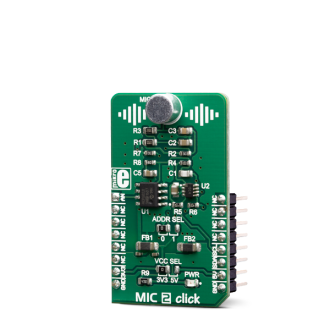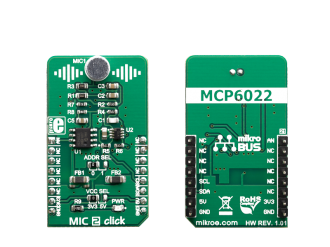
We strongly encourage users to use Package manager for sharing their code on Libstock website, because it boosts your efficiency and leaves the end user with no room for error. [more info]

Rating:
Author: MIKROE
Last Updated: 2019-04-15
Package Version: 1.0.0.0
mikroSDK Library: 1.0.0.0
Category: Microphone
Downloaded: 4704 times
Not followed.
License: MIT license
MIC 2 click is equipped with a small electret microphone, accompanied by a suitable pre-amplifying circuit. The small electret microphone is not capable of providing sufficient line-level output; therefore, the pre-amp has to be used.
Do you want to subscribe in order to receive notifications regarding "MIC 2 click" changes.
Do you want to unsubscribe in order to stop receiving notifications regarding "MIC 2 click" changes.
Do you want to report abuse regarding "MIC 2 click".


Library Description
The library contains functions with reading values ​​from the ADC and setting the potentiometer over the I2C lines. The values returned by MIC 2 click, the user can see on the Serial plot.
Key functions:
void mic2_setPotentiometer(uint8_t ptt_value) - Functions for sets resistance of the potentiometer.uint32_t mic2_adcRead() - ADC read.void mic2_adcSetInputChannel() - ADC set channel.void mic2_adcInit() - ADC init.Examples description
The application is composed of the three sections :
void applicationTask( )
{
uint16_t adcValue;
adcValue = mic2_adcRead();
plotData( adcValue );
}
Additional Functions :
Other mikroE Libraries used in the example:
I2CUARTADCAdditional notes and informations
Depending on the development board you are using, you may need USB UART click, USB UART 2 click or RS232 click to connect to your PC, for development systems with no UART to USB interface available on the board. The terminal available in all MikroElektronika compilers, or any other terminal application of your choice, can be used to read the message.